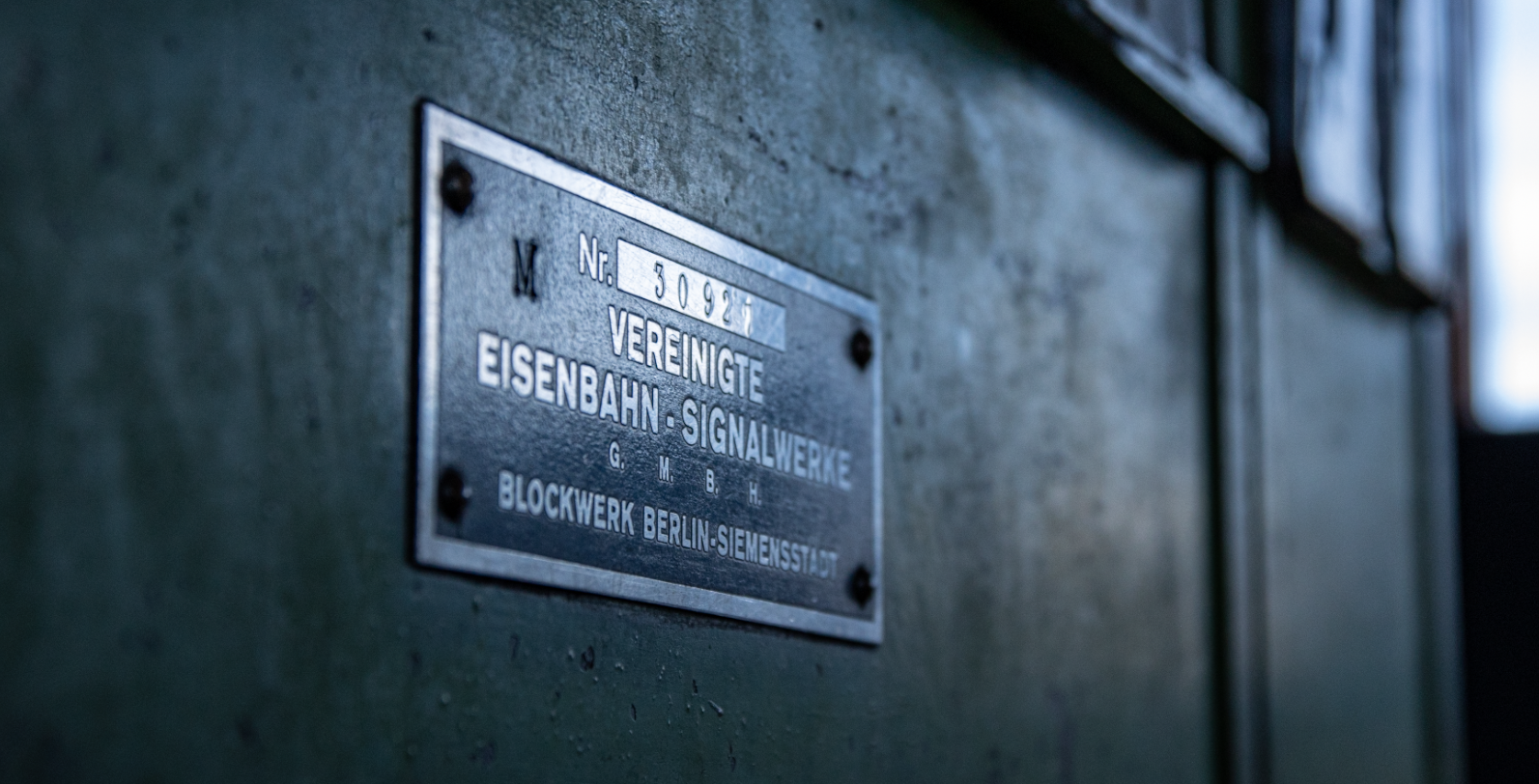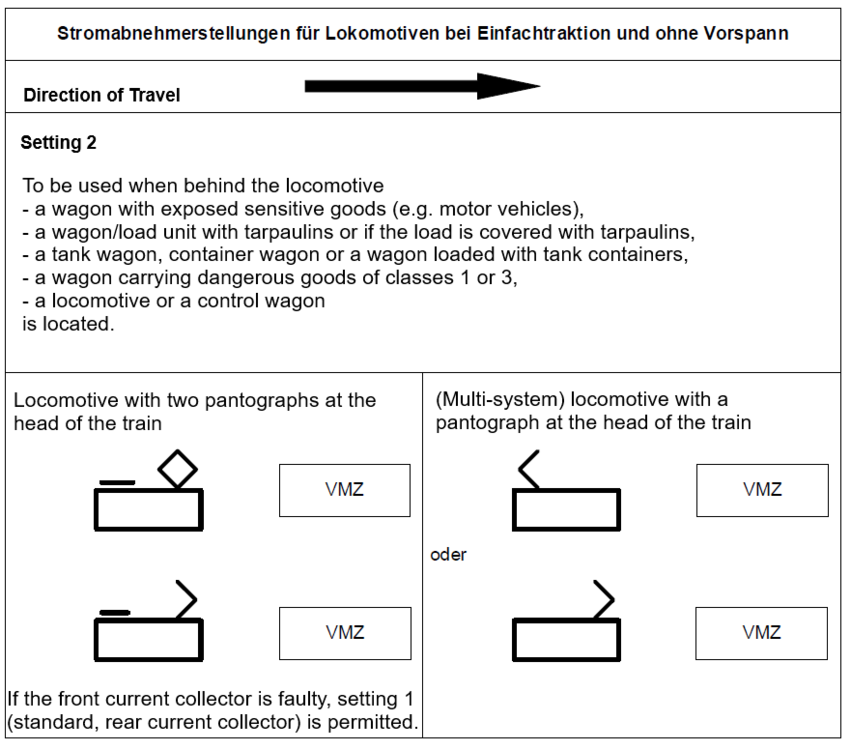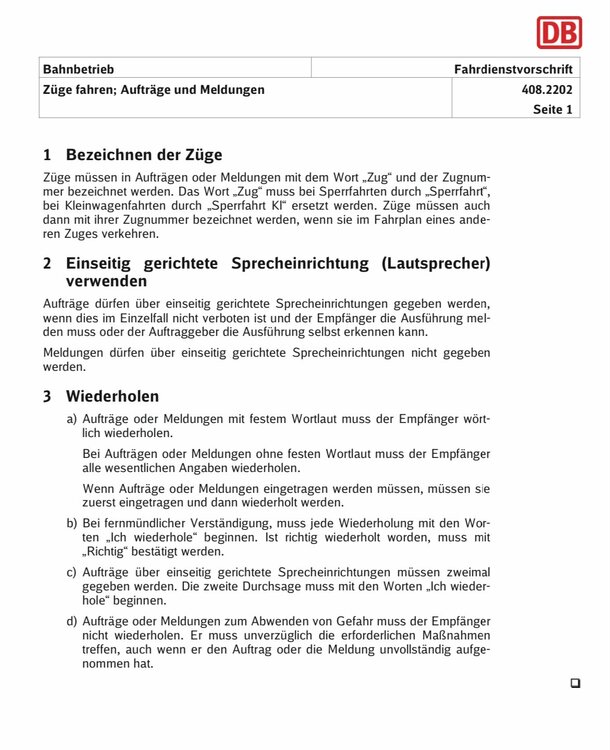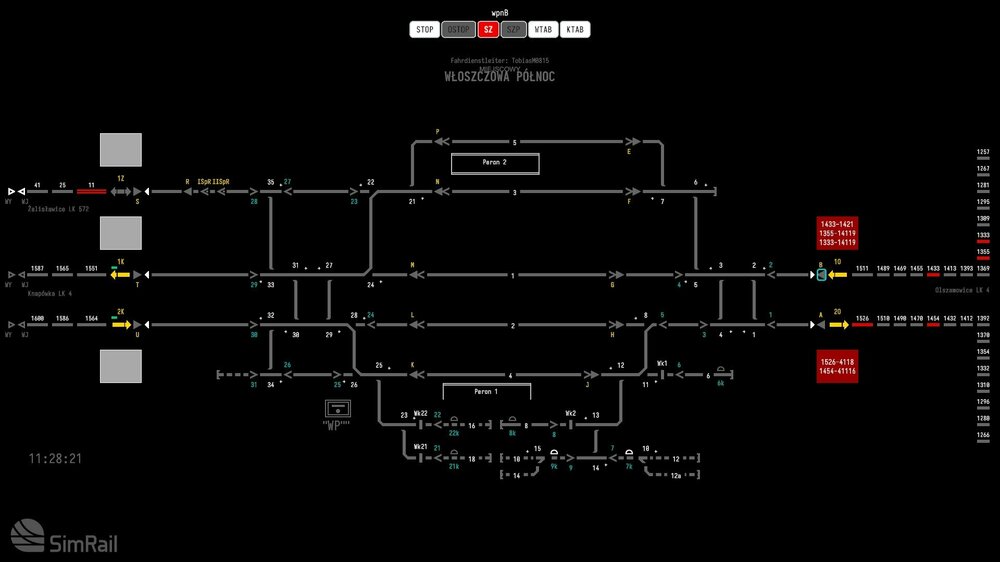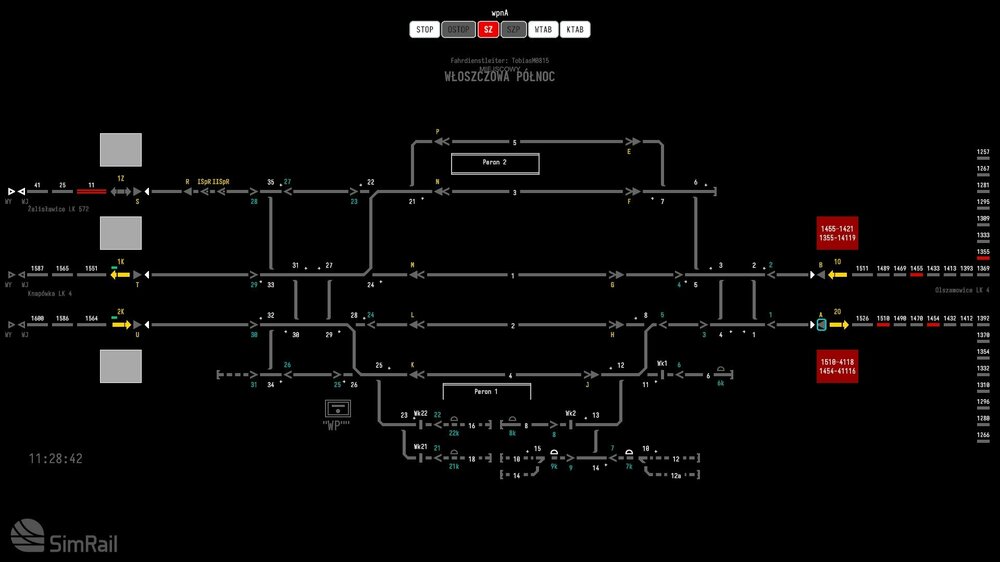-
Posts
23 -
Joined
-
Last visited
-
Days Won
1
Other groups
Early Access
Playtests
TobiasM0815 last won the day on June 16 2023
TobiasM0815 had the most liked content!
Reputation
52 ExcellentRecent Profile Visitors
374 profile views
-
Even if it is not in Poland, in the German regulations for train crews (called: "Betriebsregelwerk") you can find the following overview, which I have translated for you. I think there are similar regulations in Poland.
-
Możesz już wywołać to, co widzisz na filmie. Menu dewelopera musi być aktywowane w misji dla jednego gracza. https://wiki.simrail.eu/LUA/developer-tools Jednak rzeczywisty scenariusz nadal musi być napisany ręcznie jako program Lua.
-
That was the problem. I put it in the primal function, then it worked! Thanks for your help!
-
Thank you for your answer! I have increased the range to 130. Unfortunately it does not work. "ScenarioStep" seems to remain at the value "neutral" and is not changed to "LAcoupled", so that the message "No action on radio call here" continues to appear at pressing ZEW1 after coupling to the cars. I am at a bit of a loss. ^^
-
Hello, I'm taking my first steps in Lua and I'm having a lot of fun. I don't really have any programming skills, but it's all logical. However, after a few hours of tinkering I've reached a problem where I'm stuck. The goal: After I arrive with my locomotive behind signal E114 in Lazy and have coupled it to the wagons, a route is to be set after ZEW1. However, the SignalTrigger does not recognize my stopping locomotive. Enclosed is the code, with a request for help. Perhaps someone can see the problem at first glance. Thank you for your help! -- SimRail - The Railway Simulator -- LUA Scripting scenario -- Version: 1.0 -- require("SimRailCore") DeveloperMode = function() return true end StartPosition = {17788.41, 338.47, 23638.06} ScenarioStep = "basic" Sounds = {} --- Function called by SimRail when the loading finishes - you should set scenario time in here, spawn trains etc. After calling this mission recorder is started and stuff gets registered function StartScenario() StartRecorder() DisplayChatText("LuaText2") SetWeather(WeatherConditionCode.ClearSky, 26, 1000, 100, 2000, 0, 10, 0, true) PlayerTrainset = SpawnTrainsetOnSignal("Player", FindSignal("LA_Tm2"), 10, true, true, false, true, { CreateNewSpawnFullVehicleDescriptor(LocomotiveNames.ET22_836, false, "", 0, BrakeRegime.P), }) PlayerTrainset.SetRadioChannel(2, true) PlayerTrainset.SetState(DynamicState.dsStop, TrainsetState.tsShunting, true) PlayerTrainset.SetAllowCouplerAttach(true) PlayerTrainset.SetAllowCouplerDetach(true) SpawnTrainsetOnSignalAsync("Cargo", FindSignal("LA_E114"), 40, false, false, true, { CreateNewSpawnFullVehicleDescriptor(FreightWagonNames._441V_31516635283_3, true, FreightLoads_412W_v4.Coal, 70, BrakeRegime.P), CreateNewSpawnFullVehicleDescriptor(FreightWagonNames._441V_31516635283_3, true, FreightLoads_412W_v4.Coal, 70, BrakeRegime.P), CreateNewSpawnFullVehicleDescriptor(FreightWagonNames._441V_31516635512_5, true, FreightLoads_412W_v4.Coal, 70, BrakeRegime.P), }, function (trainset) Trains[1] = trainset trainset.SetAllowCouplerAttach(true) trainset.SetAllowCouplerDetach(true) end) end --- Function below is called by SimRail when VD is ready to start receiving orders function OnVirtualDispatcherReady() Log("Ready!") ScenarioStep = "start" end function OnPlayerRadioCall(trainsetInfo, radio_SelectionCall) if(ScenarioStep == "neutral") then Log("No action on radio call here") end if(ScenarioStep == "start") then ScenarioStep = "neutral" CreateCoroutine(function () VDSetRoute("LA_Tm2", "LA_Tm15", VDOrderType.ManeuverRoute) VDSetRoute("LA_Tm15", "LA_Tm125", VDOrderType.ManeuverRoute) end) end if(ScenarioStep == "LAcoupled") then CreateCoroutine(function () VDSetRoute("LA_E114", "LA_Tm7", VDOrderType.ManeuverRoute) end) end end CreateSignalTrigger(FindSignal("LA_E114"), 5, { check = UnconditialCheck, result = function(e) CreateCoroutine(function() coroutine.yield(CoroutineYields.WaitForVehicleStop, RailstockGetPlayerTrainset().Vehicles[1]) ScenarioStep = "LAcoupled" Log("Now Ready for new radio call!") end) end })
-

Sneak Peek for the non-Discord users
TobiasM0815 replied to Dolphin Invasion's topic in General Discussion [Multiplayer]
Yes, in real life there are 2 cameras, because the SKP-Station (had the job to look for the tail light/signs) was closed and this task got over to the dispatcher. And for this he needs the 2 cameras. Beforehand, you are not allowed to operate the line block (Ko). -

Sneak Peek for the non-Discord users
TobiasM0815 replied to Dolphin Invasion's topic in General Discussion [Multiplayer]
Oh nice! It seems that there will be TVU-Cameras in future. Dąbrowa Górnicza Wschodnia need it as well.. -
Die wesentlichen Regelungen zur Kommunikation sind bei der DB in der Richtlinie 481 festgelegt. (Öffentlich verfügbar) Regelungen zu drahtgebundenen Fernsprecheinrichtungen (z.B. Fdl-Fdl Verbindungen): https://fahrweg.dbnetze.com/resource/blob/9722792/fa453c09881281bebde9a6ef3ff11c36/rw_481-0101-data.pdf Regelungen zu Verbindungen im analogen Zugfunk (am ehesten vergleichbar mit dem polnischen Funk als offener Kanal): https://fahrweg.dbnetze.com/resource/blob/9722806/f00babf226ee3f974c79f75e0fc3c7b4/rw_481-0202_aktualisierung_1-data.pdf Zusätzlich gilt 408.2202 (Ebenfalls öffentlich verfügbar) Es gilt also keine einheitliche Phaseologie wie z.B. im Flugverkehr. Eher ein Sammelsurium an Allgemeinen Regeln und festen Wortlauten. Außerhalb von festen Wortlauten (z.B. bei Zugmeldungen) steht es also dem Betriebspersonal weitestgehend frei, wie sie ihre Gespräche formulieren. Es muss jedoch klar und eindeutig kommuniziert werden.
-
Spontaneous events are always such a special thing. A signal disruption is something that can of course happen unforeseen and of course also has an impact on train traffic. (Happened to me irl yesterday again, driving for 2 hours with Sz signal). However, such situations require a lot of attention from the dispatcher and mistakes that can lead to very bad situations are likely to happen very often in SimRail, especially for new players. Topic workers on the tracks: In reality, we usually work in such a way that train traffic is not affected. If a worker requests a spontaneous track closure because he wants to work there, we check whether we can bypass the blocked track. If this is not possible, we will reject the requested track closure. Planned construction work is a little different: Here in Germany there are written instructions for work on the tracks (called "Betriebs- und Bauanweisung"). This contains all the important instructions and information for dispatchers, track workers, train drivers (construction trains) and construction supervisors. If this document is not available to the dispatcher or if it contains errors, we will refuse the work. In addition, there is usually a timetable instruction (called "Fahrplananordnung"), which regulates the changed timetable and any trains that may have to be diverted. Otherwise the routes would suffocate due to the limited track availability. As far as I know, there are comparable regulations in Poland. All in all, you can see that such situations are usually (more or less well) planned and rarely happen spontaneously. I suspect that the SimRail team will have to make an important decision for this in the future, whether to treat this topic more casually or more professionally. Another possibility, which I think is very good (but also see it later in the development), is a central event team from SimRail, which plans such work, if necessary create briefings for the dispatchers ..and maybe also realistic documents on this.
-
Noch eine kleine fachliche Erklärung, was dort technisch passiert: Der Block den man dort bedient ist sogenannter Relaisblock, also ein nichtselbsttätiger Streckenblock. Im Prinzip ist er die elektrische Variante des mechanischen Felderblocks. Das was ist und was macht der (Strecken-)Block der Eisenbahn eigentlich? Kurzfassung: Der Streckenblock sichert das fahren des Raumabstandes bei der Eisenbahn technisch ab. Der Rückblock ist also die technische Bestätigung über die durchgeführte Räumungsprüfung durch den Fahrdienstleiter der Räumungsprüfstelle am Ende des Zugfolgeabschnitts. Bevor man einen Zug zurückblocken kann müssen einseits fahrdienstliche Bedingungen erfolgt sein (vgl. Fahrdienstvorschrift 408.0241 (4)): Bei der Räumungsprüfung muss Folgendes festgestellt werden: a) Der Zug ist an der Signal-Zugschlussstelle des Hauptsignals (Anmerkung: idR das Stellwerksgebäude, weil der Fdl dort den Zugschluss als erstes erkennen kann) oder des Signals Ne 14 auf der Räumungsprüfstelle vorbeigefahren. b) Der Zug hat mindestens ein Zeichen des Schlusssignals. Im Betriebsstellenbuch können zusätzliche Regeln gegeben sein. c) Das Hauptsignal bzw. der Melder der virtuellen Blockstelle der Räumungsprüfstelle zeigt Halt und der Melder des Signals Zs 1, Zs 7 oder Zs 8 ist erloschen. Haltstellung und Erlöschen der Signale müssen sicher angezeigt werden. An diesem Signal dürfen Selbststellbetrieb oder Zuglenkung mit Lenkplan nicht eingeschaltet und Fahrstraßen nicht eingespeichert sein. Der Bediener muss Sperre nach Modul 408.0403 Nr. 7 anbringen. Außerdem gibt es technische Bedingungen: Bevor ein Zug zurückgeblockt werden kann, muss die elektrische Streckentastensperre ausgelöst haben. (Die weiße Lampe neben der Taste Ko) Doch was macht die? Die elektrische Streckentastensperre sperrt die Bedienung des Endfeldes (Rückblock) solange, bis eine Zugfahrt durchgeführt wurde. Sie sichert also den Streckenblock bzw. den Rockblock vor einer unzeitigen Bedienung, also einer "falschen" Freigabe des Blockabschnittes, ohne dass ein Zug gefahren ist. Dazu nutzt die elektrische Streckentastensperre die sogenannte isolierte Schiene, also ein isolierter Gleisabschnitt hinter dem Räumungsprüfsignal. Die elektrische Streckentastensperre löst also erst aus, wenn die isolierte Schiene mit erster und letzter Achse des Zuges befahren wurde. Die isolierte Schiene wird mit Fahrtstellung des Räumungsprüfsignals angeschalten, ist also in Grundstellung wirkungslos. Fahren wir nun auf Signal Sz (Ersatzsignal) steht das zur isolierten Schiene zugehörige Räumungsprüfsignal also nicht auf Fahrt und die isolierte Schiene ist wirkungslos. Folge: Blockstörung - wir können nicht zurückblocken. Für diesen Fall (Fahrt auf Sz/Zs1 bzw schriftlichen Befehl) erfand man den sogenannten Anschalter (dKo - Was oben als "Block ziehen" beschrieben wird) - damit wird die isolierte Schiene, wie der Name sagt, angeschalten und die elektrisch Streckentastensperre (Lampe neben Ko) kann auslösen und wir können zurückblocken. Vorher aber bitte immer die fahrdienstlichen Bedingungen beachten. 🙂
-
At my first "shift" at Włoszczowa Północ i cannot set up routes from entry signals B and A (also S) into the station. There aren't route suggestions when i click on the signals, only the signal menu. I have to use SZ.
- 1 reply
-
- 2
-

-
In today's update, the colors of the tracks in Dispatcher mode have been changed. Is it possible to activate or deactivate these new colors via an option? The old colors looked more realistic. If it is possible, it would also make sense to set "simplified interface" or "realistic interface". At the beginning of the playtest, the interface of the electronic interlocking seemed closer to the real technology than it does now. Thanks!
-
Derzeit nicht. Die Übersicht der Zugnummern bzw. die UI wird aber einem der zukünftigen Updates überarbeitet. Dann sollte sich dieses Problem erledigt haben.
- 1 reply
-
- 1
-

-

What are freight operations like in Poland?
TobiasM0815 replied to SurvivorSean's topic in General Discussion
Rail freight transport in Europe has two categories. There are so-called single wagon trains and block trains. The concept of single-car trains works like this: There is a transfer train for each railway line, which fetches wagons from the sidings on this line and brings them to the marshalling yard. Sometimes there are only 1-2 cars per siding. The train is quite long at the marshalling yard because there are usually many sidings on the route. There the train locomotive is uncoupled and all couplings are released, a shunting locomotive pushes the wagons over the "mountain". In rolling, the cars are now sorted according to direction. At the end, corresponding connecting trains between marshalling yards come out on all tracks. One of these transfer trains is now driving to a new marshalling yard. There it is broken up again over the "mountain" into the respective transfer trains. Which then drive back onto the tracks and deliver the wagons to the sidings, pick up new ones there and everything starts again. Block trains are easier: A very large amount of freight is transported in the same type of wagon from point A (loading) to point B (unloading), on the way at most wagon groups are rearranged or discarded. Situation in Poland today: There are actually many more passenger trains than freight trains. Single wagon traffic has come to an almost complete standstill. The classic transfer trains no longer exist. The marshalling yards are usually used to park wagons that are not required. Most freight trains are block trains (coal, ores, steel, cement, crushed stone), etc. However, there are countries in Europe where single-wagon transport is not dead and is currently becoming even more attractive thanks to good marketing. As an example Czech Republic and Germany. In Slovakia, too, there is still a lot going on at marshalling yards. -

Güterzug Annahme Anleitung für Lazy Lc Stellwerk
TobiasM0815 replied to Vanrandalos's topic in Allgemeine Diskussion [DE]
Ja KoS3 der sogenannte Rückblock - die Bestätigung der Räumungsprüfung, also einfach gesagt die Bestätigung, dass der Zug den Blockanbschnitt vollständig durchfahren hat. Vorbedingung: Du musst am Zug durch Hinsehen das Zugschlusssignal festgestellt haben.

